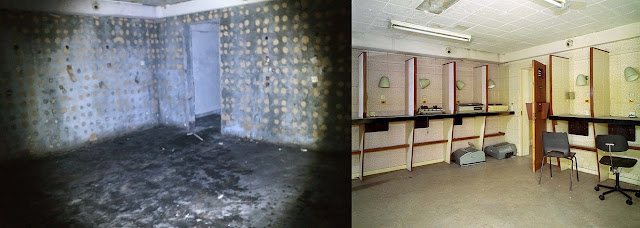Soviet targets
 |
| Cold War–era control tower at RAF Finningley |
The region's coal mines, roads, rail links and steelworks would have made attractive sites for Moscow, too. Sheffield's Forgemasters manufactured parts for Trident nuclear submarines.
The campaign for peace
That marked the start of South Yorkshire's defiance against the government's nuclear policies. In 1956 Sheffield made a gesture of friendship with a Soviet city, twinning with Stalino (now Donetsk in Ukraine). People set up local CND branches. In 1980 the County Council declared itself 'nuclear free', opposing any hosting or transportation of nuclear materials here.
In 1984 Threads, a docudrama written by Barnsley's Barry Hines (writer of Kestrel for a Knave) was broadcast. It depicted the effects of a nuclear winter in Sheffield, traumatising a generation.
It was fighting in Iran that led to the UK being hit.
South Yorkshire County Council's South Yorkshire and Nuclear War booklet
The booklet describes what would happen if central government's 1980 'Square Leg' exercise had been real. That study assumed two bombs (250 times bigger than the Hiroshima bomb) would drop in South Yorkshire, one on Eccleshall Road in Sheffield, and one near Finningley airfield near Doncaster.
A blinding flash of light, then a huge fireball as hot as the sun incinerates everything beneath it. Blast winds destroy buildings, sucking up tonnes of dust into a mushroom cloud. At the impact point, each bomb leaves a crater a third of a mile across and 300 feet deep. Cars melt, rivers run dry and people burn. Those in shelters are roasted.
Any survivors bear hideous injuries and burns and face a nuclear winter. The skies are dark with smoke and dust. Chemical smog chokes the atmosphere and temperatures drop to –23°C. Eventually everyone dies. Only insects and grass remain.
The Council considered the Home Office's Square Leg prediction of 190,000 dead (within six weeks) in South Yorkshire an underestimate. It commissioned an independent computer simulation, and concluded 934,000 would die out of 1,292,000 residents.
It described the belief in the need for nuclear weapons as 'absurd', comparing it to a householder blowing their house up to stop being burgled. On the likelyhood of nuclear war, there's no message of hope. It said "every arms race in history has ended in war, and it seems doubtful the nuclear arms race will be an exception".
What remains today
 |
| A bunker next to the (locked) ROC bunker at Lindholme |
Regional government headquarters were built underground. There's one in Conisbrough, which is now a private house, and there are bunkers under Cusworth Hall and Barnsley County Hall. Doncaster's Emergency Borough Control Centre was on Cleveland Street, underneath the Coroner's Office. It was demolished last year.
 |
| Doncaster Borough Control – 2017 and 2001 (latter photo: Nick Catford) |
 |
| Bunker at Cusworth Hall (South Yorkshire and Nuclear War, 1984) |



